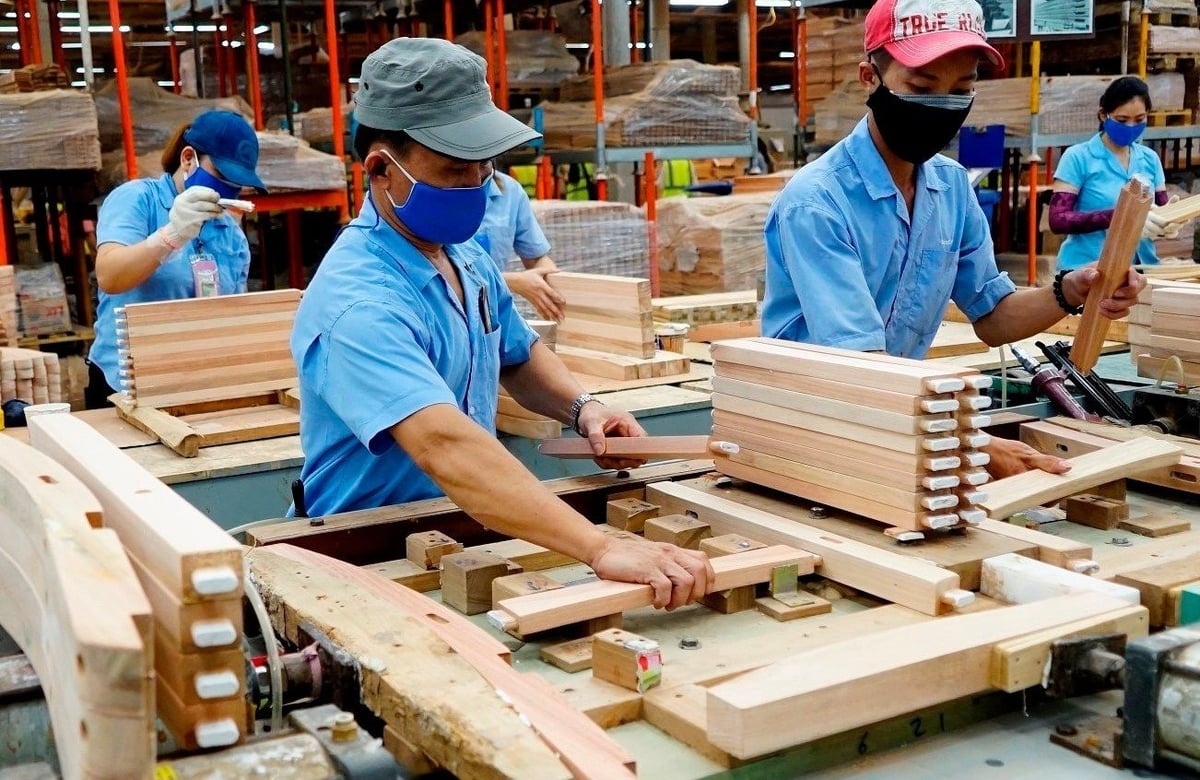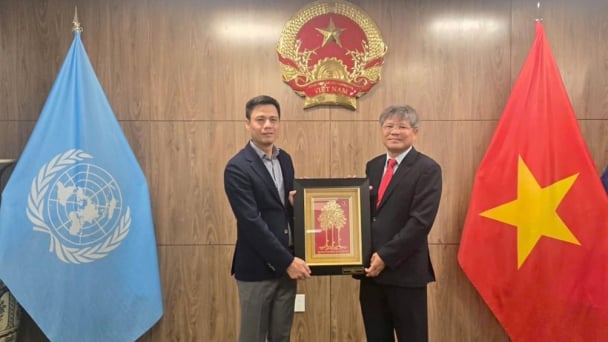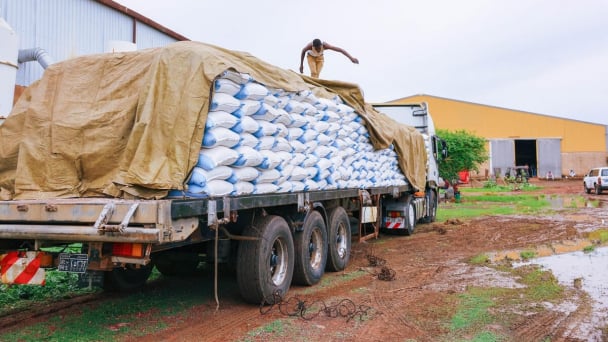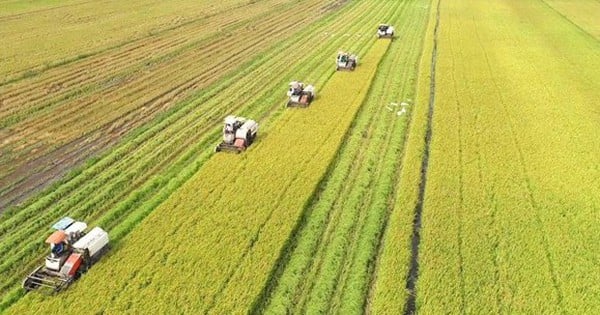May 22, 2025 | 14:18 GMT +7
May 22, 2025 | 14:18 GMT +7
Hotline: 0913.378.918
May 22, 2025 | 14:18 GMT +7
Hotline: 0913.378.918
At the meeting of the forestry sector held on the morning of April 4, Mr. Ngo Sy Hoai, Vice Chairman and General Secretary of the Association of Vietnam Timber and Forest Product, stated that all members of the association have adopted a spirit of resilience and determination in response to the recent announcement by the US of a 46% reciprocal tariff on goods originating from Vietnam.

Deputy Minister Nguyen Quoc Tri chaired the forestry sector meeting. Photo: Bao Thang.
Compared to other sectors, wood and wood products are forecasted to be among the most heavily impacted by the new tariff measures. In 2024, exports of wood products to the US accounted for over 55% of the industry's total export value - nearly twice the average for the entire economy (around 30%).
Several wood product categories reached export values of over USD 1 billion, such as: seating furniture at USD 2.78 billion (making up 31.6% of wood export value to the U.S.); other wooden furniture at approximately USD 1.53 billion (17.4%); bedroom wooden furniture at USD 1.19 billion (13.5%); and kitchen wooden furniture at USD 1 billion (11.5%), among others.
All of these products fall under the category of refined wooden furniture, with total exports to the U.S. in 2024 reaching USD 8 billion. Starting in early 2025, the US launched an investigation into Vietnam’s high-value wooden products, based on Section 232 of the Trade Expansion Act.
According to Mr. Ngo Sy Hoai, the association had anticipated the possibility that the US might raise tariffs on these products, but the expected rate was only around 25%.
"The imposition of a 46% countervailing tariff caught us all by surprise," he shared, adding that as soon as the information was received on the morning of April 3, the entire association began reviewing the situation and reaching out to relevant agencies to obtain detailed updates.
After one day of work, the association discovered that industrial wood panels - which had an export value of approximately USD 800 million to the US in 2024 - were not included in the list of items subject to the new countervailing tariffs (which will take effect from April 9). "We are quite puzzled by this," Mr. Hoai admitted.

Mr. Ngo Sy Hoai: "The association is concerned about the list of items subject to reciprocal tariffs." Photo: Bao Thang.
Providing further information on the issue, a representative from the International Cooperation Department under the Ministry of Agriculture and Environment stated that early in the morning of April 4, the Department contacted the US side and learned that there are still many products President Donald Trump intends to increase tariffs on, but which have not yet been included in the countervailing tariff list announced on April 2.
According to the Department's findings, the US will continue to review which products are subject to the new tariffs, based on directives from President Trump. “The wood industry needs to maintain close communication in order to stay continuously updated on the new tariff measures and be able to adjust in a timely manner,” the official noted.
Initial estimates have already been made regarding the potential losses to the timber industry if subjected to a 46% countervailing duty. Vice Chairman Ngo Sy Hoai stated that businesses are still waiting for the Government to step in and negotiate with the US to consider reducing trade barriers, and to implement policies that balance the interests of both sides - such as delaying the effective date of the tax imposition.
“For a long time, US regulations on wood imports have been relatively lenient, which may have led some timber enterprises to become complacent,” commented the leader of the Vietnam Timber and Forest Products Association. He further noted that this immediate challenge could also serve as a driving force for businesses to fundamentally shift their growth model.
Previously, many enterprises focused heavily on increasing export value, often neglecting the goal of profit growth - which is, in fact, the key factor ensuring the long-term quality and sustainability of business development.

Delegates discuss the upcoming goals for the sector. Photo: Bao Thang.
Another issue is that businesses appear to be overlooking potential markets such as Japan, where Vietnam currently exports mainly wood pellets and wood chips, along with China, which primarily imports wood chips. By actively fostering partnerships with companies from these countries, the timber industry could create new growth opportunities.
Lastly, there is a need to increase the value-added content in processing. In the past, most Vietnamese export enterprises operated mainly on an outsourcing basis, fulfilling pre-designed orders with low added value. Mr. Hoai noted that if enterprises could incorporate design stages or enhance the level of craftsmanship, the products would become more valuable and help elevate the Vietnamese brand on the global stage.
In the long term, Mr. Hoai recommended that the Ministry of Agriculture and Environment, along with the Forestry and Forest Protection Department, study policies to support Vietnamese businesses investing in the US. This is something that former President Trump welcomed, and Vietnam has many opportunities given the strong demand for timber products in the US market. For instance, Vietnamese wooden cabinets currently account for over 30% of the US market share.
Additionally, the US grants tax exemptions for certain products that meet specific localization requirements or use US-originated materials. “If we import timber from the US, process it in Vietnam, and then re-export it back, we may be eligible for tariff incentives,” Mr. Hoai explained.

The timber industry is among the sectors most affected by thereciprocal tariff. Photo: Viforest.
In a strong show of commitment to supporting businesses, Deputy Minister Nguyen Quoc Tri instructed the Forestry and Forest Protection Department to promptly consolidate data and report on issues related to the newly imposed countervailing duties. This includes a clear analysis of how enterprises in the timber industry are expected to be affected by the new tariff measures.
“We will provide policy recommendations to the Government and engage with industry associations as soon as possible to identify appropriate response strategies,” the Deputy Minister emphasized. He also directed the International Cooperation Department to quickly and timely communicate with international partners, including those in the United States, regarding Vietnam’s ongoing efforts to ensure transparency and traceability of product origin, as well as to maintain balanced two-way trade.
In April, the Forestry and Forest Protection Department will coordinate with the Association of Vietnam Timber and Forest Product to organize a sectoral briefing for the timber industry. During this meeting, stakeholders will conduct an in-depth assessment of the impacts and propose responsive solutions to US policy adjustments, while closely monitoring developments related to the US Department of Commerce’s initiation of an investigation into potential threats to national security from the importation of logs, sawn timber, and related products.
In the first two months of 2025, Vietnam’s total export value of wood and wood products reached USD 2.45 billion, marking a 9.4% increase compared to the same period in 2024. Of this, the US remained the leading market, accounting for USD 1.3 billion, a 9.5% rise year-on-year.
One of the key tasks of the forestry sector is to advise, propose, and issue legal normative documents. In the first three months of 2025, the Forestry and Forest Protection Department, in coordination with the Department of Nature Conservation and Biodiversity, completed a draft decree amending Decree No. 06/2019/ND-CP and Decree No. 160/2013/ND-CP on the management of endangered, precious, and rare species of wild fauna and flora.
Translated by Kieu Chi
![Reducing emissions from rice fields: [3] New values generated from carbon credit](https://t.ex-cdn.com/nongnghiepmoitruong.vn/608w/files/content/2025/05/19/dsc09613-144700_71-150957.jpg)
(VAN) In addition to helping safeguard the environment, the low-emission rice cultivation model also generates new opportunities for farmers by leveraging the carbon credit market.
![Ho Chi Minh city adapts to climate change: [1] Vulnerable in the whirlwind of development](https://t.ex-cdn.com/nongnghiepmoitruong.vn/608w/files/duyenht92/2025/05/19/3131-ngap-nongnghiep-163121.jpg)
(VAN) As the country's economic engine with a rapid urbanization rate, Ho Chi Minh city is facing increasingly serious consequences of climate change.

(VAN) On May 21, Minister of Agriculture and Environment Do Duc Duy worked with Mr. Olivier Brochet, Ambassador Extraordinary and Plenipotentiary of the French Republic to Vietnam.

(VAN) VRG recently conducted a visit and working trip to the United States to demonstrate its efforts in redefining the role of rubber enterprises in the global value chain.

(VAN) In 2024, over 295 million people across 53 countries and territories faced acute hunger—an increase of almost 14 million people compared to 2023, while the number of people facing catastrophic levels of hunger reached a record high.

(VAN) World Environment Day 2025 (June 5) carries the theme 'Beat Plastic Pollution' continuing to emphasize the global urgency of addressing the plastic waste crisis.

(VAN) This was the assessment shared by experts at the workshop titled 'Assessing the Role and Potential of Low-Emission Rice Production Systems in Vietnam,' held on the morning of May 19.